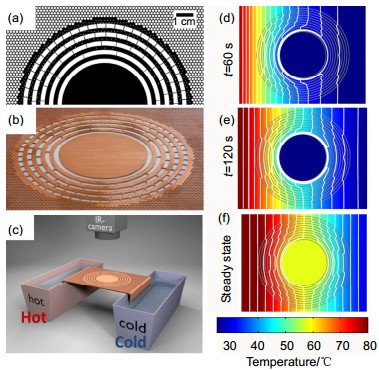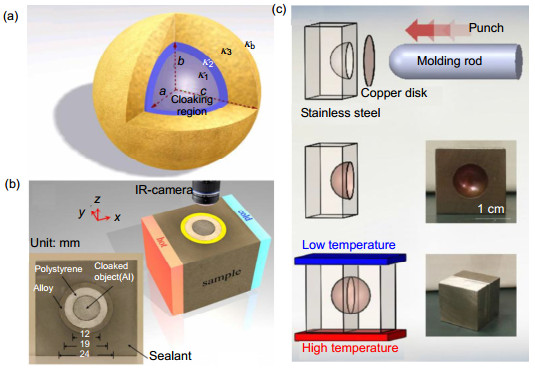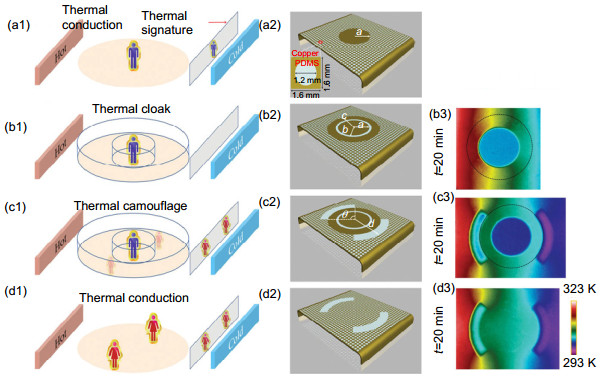| Citation: | Xiangfan Xu, Baowen Li. Transformation thermotics and the manipulation of thermal energy[J]. Opto-Electronic Engineering, 2017, 44(1): 64-68. doi: 10.3969/j.issn.1003-501X.2017.01.005 |
Transformation thermotics and the manipulation of thermal energy
-
Abstract
Thermal energy has been proposed to have ever greater potential for human beings if the heat carriers, i.e. phonons can be controlled in micron scale as easy as its counterpart, electrons in solid. Alternatively, in macroscopical scale, functional thermal materials are used to control thermal energy. The transformation of macroscopical thermal diffusion equation is proposed to obtain the asymmetrical thermal conductivity in real space. This new type of thermal functional materials helps to control heat flow and to realize thermal cloak and thermal camouflage. -

-
References
[1] 沈翔瀛, 黄吉平.热超构材料的研究进展[J].物理, 2013, 42(3): 170-180. Shen Xiangying, Huang Jiping. Research progress in thermal metamaterials[J]. Physics, 2013, 42(3): 170-180. [2] 徐象繁, 周俊, 杨诺, 等.人工微结构材料与热的调控[J].中国科学:技术科学, 2015, 45(7): 705-713. Xu Xiangfan, Zhou Jun, Yang Nuo, et al. Artificial microstructure materials and heat flux manipulation[J]. Scientia Sinica Technologica, 2015, 45(7): 705-713. [3] Leonhardt U. Optical conformal mapping[J]. Science, 2006, 312(5781): 1777-1780. [4] Pendry J B, Schurig D, Smith D R. Controlling electromagnetic fields[J]. Science, 2006, 312(5781): 1780-1782. doi: 10.1126/science.1125907 [5] Schittny R, Kadic M, Guenneau S, et al. Experiments on transformation thermodynamics: molding the flow of heat[J]. Physical Review Letters, 2013, 110(19): 195901. doi: 10.1103/PhysRevLett.110.195901 [6] Narayana S, Sato Y. Heat flux manipulation with engineered thermal materials[J]. Physical Review Letters, 2012, 108(21): 214303. [7] Han Tiangcheng, Bai Xue, Gao Dongliang, et al. Experimental demonstration of a bilayer thermal cloak[J]. Physical Review Letters, 2014, 112(5): 054302. doi: 10.1103/PhysRevLett.112.054302 [8] Xu Hongyi, Shi Xihang, Gao Fei, et al. Ultrathin three-dimen-sional thermal cloak[J]. Physical Review Letters, 2014, 112(5): 054301. doi: 10.1103/PhysRevLett.112.054301 [9] Alù A. Thermal cloaks get hot[J]. Physics, 2014, 7: 12. doi: 10.1103/Physics.7.12 [10] Han Tiancheng, Bai Xue, Thong J T L, et al. Full control and manipulation of heat signatures: cloaking, camouflage and thermal metamaterials[J]. Advanced Materials, 2014, 26(11): 1731-1734. doi: 10.1002/adma.201304448 [11] Li Baowen, Lan Jinghua, Wang Lei. Interface thermal resistance between dissimilar anharmonic lattices[J]. Physical Review Letters, 2005, 95(10): 104302. doi: 10.1103/PhysRevLett.95.104302 [12] Li Baowen, Wang Lei, Casati G. Thermal diode: rectification of heat flux[J]. Physical Review Letters, 2004, 93(18): 184301. doi: 10.1103/PhysRevLett.93.184301 [13] Terraneo M, Peyrard M, Casati G. Controlling the energy flow in nonlinear lattices: a model for a thermal rectifier[J]. Physical Review Letters, 2002, 88(9): 094302. doi: 10.1103/PhysRevLett.88.094302 [14] Wang Lei, Li Baowen. Thermal logic gates: computation with phonons[J]. Physical Review Letters, 2007, 99(17): 177208. doi: 10.1103/PhysRevLett.99.177208 [15] Wang Lei, Li Baowen. Thermal memory: a storage of phononic information[J]. Physical Review Letters, 2008, 101(26): 267203. doi: 10.1103/PhysRevLett.101.267203 [16] Li Nianbei, Ren Jie, Wang Lei, et al. Colloquium: phononics: manipulating heat flow with electronic analogs and beyond[J]. Reviews of Modern Physics, 2012, 84(3): 1045-1066. doi: 10.1103/RevModPhys.84.1045 [17] Han Tiancheng, Yuan Tao, Li Baowen, et al. Homogeneous thermal cloak with constant conductivity and tunable heat localization[J]. Scientific Reports, 2013, 3: 1593. doi: 10.1038/srep01593 [18] Han Tiancheng, Zhao Jiajun, Yuan Tao, et al. Theoretical realization of an ultra-efficient thermal-energy harvesting cell made of natural materials[J]. Energy & Environmental Science, 2013, 6(12): 3537-3541. [19] Kadic M, Bückmann T, Schittny R, et al. Metamaterials beyond electromagnetism[J]. Reports on Progress in Physics, 2013, 76(12): 126501. doi: 10.1088/0034-4885/76/12/126501 [20] Moccia M, Castaldi G, Savo S, et al. Independent manipulation of heat and electrical current via bifunctional metamaterials[J]. Physical Review X, 2014, 4(2): 021025. doi: 10.1103/PhysRevX.4.021025 [21] Ma Yungui, Liu Yichao, Raza M, et al. Experimental demonstration of a multiphysics cloak: manipulating heat flux and electric current simultaneously[J]. Physical Review Letters, 2014, 113(20): 205501. doi: 10.1103/PhysRevLett.113.205501 [22] Li Ying, Shen Xiangying, Wu Zuhui, et al. Temperature-depen-dent transformation thermotics: from switchable thermal cloaks to macroscopic thermal diodes[J]. Physical Review Letters, 2015, 115(19): 195503. doi: 10.1103/PhysRevLett.115.195503 -
Overview

Abstract:Thermal energy has been proposed to have ever greater potential for human beings if the heat carriers, phonons can be controlled in micron-scale as easy as its counterpart, electrons in solid. However, it is a challenge to control phonons due to its relatively short wavelength, which is in the order of a few nanometers to a few tens of nanometers. Alternatively, in macroscopical scale, functional thermal materials are used to control thermal energy. The transformation of macroscopical thermal diffusion equation is proposed to obtain the asymmetrical thermal conductivity in real space. This new type of thermal functional materials helps to control heat flow and to realize thermal cloak and thermal camouflage. In this review, we summarize the recent advances in constructing thermal functional materials (also called thermal metamaterials). In Sec Ⅰ, we discussed the history of functional materials and the principles of constructing thermal functional materials, special focus was given to the thermal cloak, followed by the realization of thermal cloak in Sec Ⅱ.Thermal camouflage, based on the realization of thermal cloak, was discussed in Sec Ⅲ, which is proposed to have great potentials in military usage. We stressed both the principle and practical based challenges in thermal cloak and thermal camouflage in Sec Ⅳ, in which outlooks were also given.
It is worth noting that thermal transports consist of thermal conduction, thermal convection and thermal radiation. Recent progresses on thermal functional materials are based on the transformation of thermotics, i.e. spacial distortion of thermal conducting path, leaving thermal convection and thermal radiation untouched. We hope, though this review paper, to encourage more researchers in China to engage in this field, and to accelerate the practical usage of thermal cloak and thermal camouflage.
-
Access History

- Figure 1.
- Figure 2.
- Figure 3.
- Figure 4.

 E-mail Alert
E-mail Alert RSS
RSS
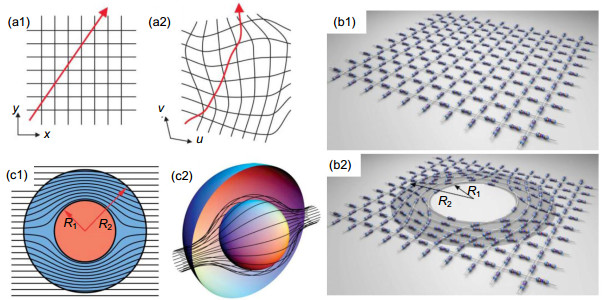

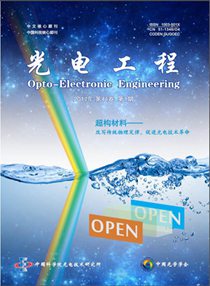
 DownLoad:
DownLoad:
